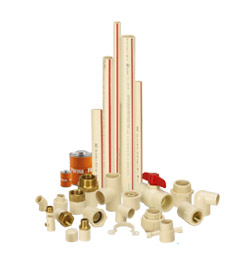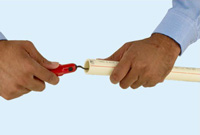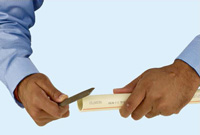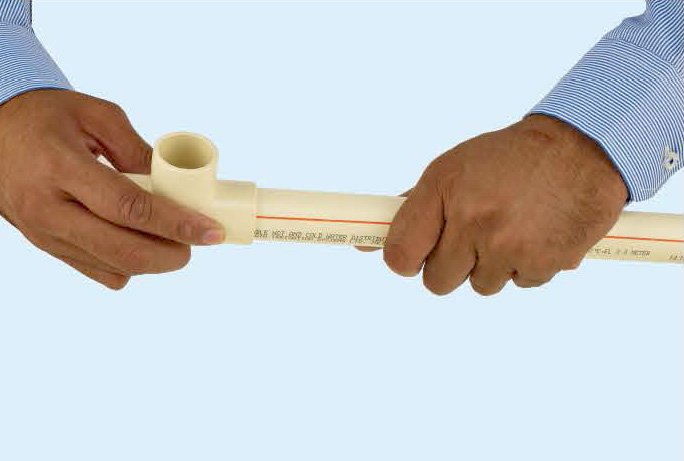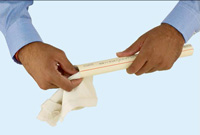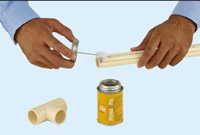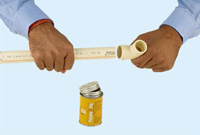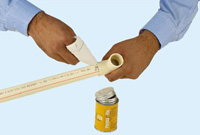 |
|
|
Standard and RangeJain Plumbing CPVC pipes are manufactured to IS 15778, from specially formulated compound conforming to or exceeding the requirements of CPVC compound of cell classificati on " D.P.110-2-3-2 " as per IS 15225. Features & Advantages
ANSI 14 The standard contains physical, performance and quality requirments and also requires ongoing monitoring for plastic piping system components and related materials. Pipe Dimension ChartJain Plumbing CPVC pipes are manufactured in different pipe diameters of copper tube size (CTS). The pipes are manufactured in size range from ½" to 2" in SDR 11 & SDR 13.5.
Installation ProcedureFor fast and reliable joints of CPVC pipes and fittings use Permafix CPVC solvent cement and follow the below explained steps-
Do’s
Don’ts
Frequently Asked Questions1) What is Thermal Expansion? – Expansion and contraction of piping systems due to temperature changes is not unique to plastics. Changes in temperature tend to cause a change in dimensions of any matter. But, the amount of dimensional change for a given temperature change can vary significantly depending on the material characteristics. 2) How to restrain thermal expansion? – The restraining of the tendency of a piping system to expand/contract can result in significant stress reactions in pipe and fittings, or between the piping and its supporting structure. The allowing of a moderate change in length of an installed piping system as a consequence of a temperature change is generally beneficial. Allowing controlled expansion/contraction to take place in one part of a piping system is an accepted means to prevent added stresses to rise to levels in other parts of the system that could compromise the performance of, or cause damage to the structural integrity of a piping component, or to the structure which supports the piping. Everyone is familiar with the typical expansion loops that are periodically placed in long pipelines subject to wide temperature changes 3) How to prevent freezing? –There are two very reliable methods of providing freeze protection and/or temperature maintenance: external electrical heat tracing using "self–regulating" style electrical heaters, and the internal method of using a smaller diameter pipe that conveys a hot fluid to transfer heat to the fluid flowing in the annular space. Both methods require a slightly different design method, and also require their own unique fabrication techniques which need to be done during pipe installation. In case no care is taken during pipe installation, but still there is chance of exposure of pipes to freezing temperatures, it is important to fill the pipes with glycerin solution. High purity glycerin and propylene glycol solutions are the best antifreeze liquids. 4) What is the effect of excessive use of solvent cement? – An installation problem that we occasionally see is the use of excessive solvent cement. The solvents in the cement themselves are readily absorbed into the wall of the CPVC pipe and inside fitting socket resulting in solvation/softening of the material. The solvents in the cement absorbed into the pipe wall resulting in softening of the pipe wall to the point that the pipe wall became swollen/ softened and no longer had sufficient strength to hold water pressure resulting in failure. 5) What is the effect of insufficient use of solvent cement? –Sufficient solvent cement must be applied to end up with complete coverage of the matting portion of pipe outer and fittings inner surface so that a continuous bond is formed between the pipe and fitting surfaces. If insufficient cement is used, voids may develop in between the pipe and fitting. The presence of the voids results in a weakened assembly which may result in water leaking from the joint. 6) What is the life of CPVC? –CPVC pipe and fittings, when installed underground as per the laid down procedures had a life expectancy of more than 50 years. CPVC pipes installed decades ago are still working satisfactorily. 7) What is the effect of external contacting material on the life of CPVC pipes & fittings? –Care must be taken not to allow CPVC pipes to contact other materials that contain aromatic ester plasticizers and flame retardants. Phthalate esters are highly incompatible with CPVC pipes. Direct contact of such material with CPVC pipes results in premature failure. Solder flux is another material that may contain chemicals that are incompatible with CPVC. If copper pipes are being soldered in the vicinity of CPVC pipes, hot flux can fall, spatter, or vaporize and condense on the outside surface of the CPVC pipes causing ESC failure.Polyurethane spray foam (PUSF) insulation can be a problem. PUSF generates heat as it cures. If the heat is trapped by a thick layer of foam against the wall of the pipe, the heat can weaken and distort the pipe. Also, each PUSF manufacturer has formulations that contain additives such as fire retardants. Some of these formulations may not be compatible with CPVC. one should consult with the PUSF manufacturer before applying PUSF in spaces where it may contact CPVC pipes & fittings for its chemical compatibility with CPVC. 8) Can we use CPVC pipes and fittings immediately after the solar water heater storage tank? – YES, Jain CPVC pipes and fitting can be used immediately after the water storage tank of solar water heater. There will not be any problem with it provided that it is properly prevented against UV lights. 9) Can we use CPVC pipes & Fittings immediately after gas water heater? –Use of CPVC pipes immediately after the gas water heaters is permitted with some restriction. A care should be taken in such a way that at no point of time the flue gases from the heater directly or indirectly come in contact with the CPVC pipe, as the passing flue gases supply external heat to the pipe and if the flue gases temperature is high enough, it may damage the pipe. if flue gases cannot be controlled, in such cases avoid the use of CPVC pipe immediately after the gas water heater. 10) What extra care to be taken while installation of CPVC pipes & fittings in a construction? Some products that are used in construction may contain chemicals that are not compatible with CPVC pipes and fittings. Therefore care must be exercised during installation to make sure that only chemically compatible products (e.g., metal pipe thread sealants, fire caulks, antifreeze, antibacterial lined pipes, etc.) are used during installation. |
|
Jain Logic
Resource To Root
More Crop Per Drop
Solution for Crop
24/7 Drinking Water Solutions
|
|||||
|
|
| Head Office: Jain Plastic Park, NH No.6 Bambhori, Jalgaon 425001.Maharashtra, India. Tel: +91 257 225 8011., |

